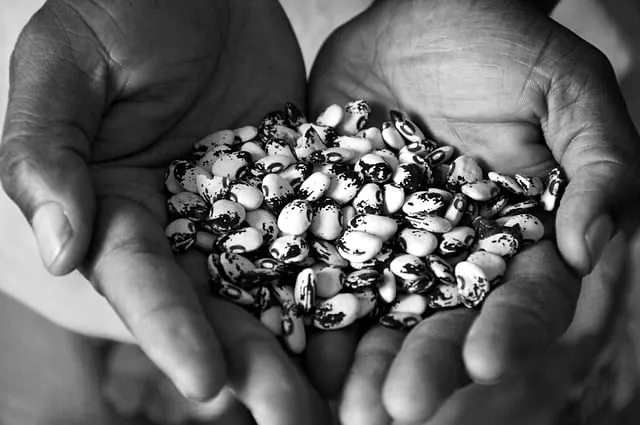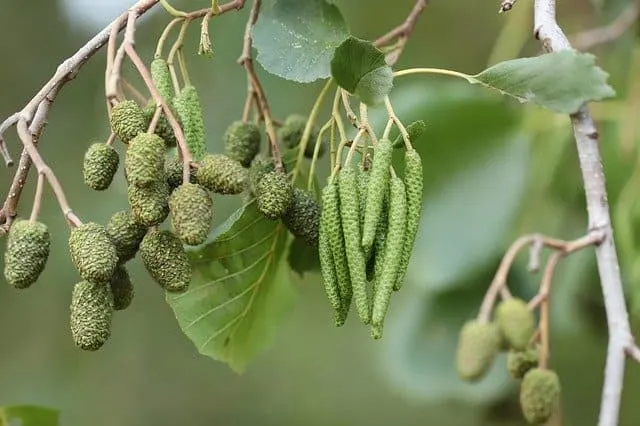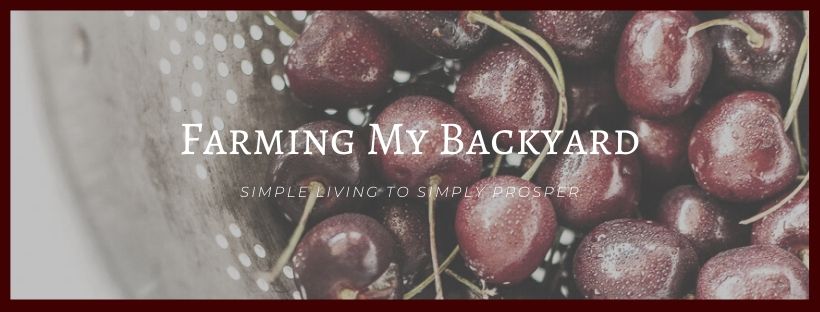Nitrogen fixers are an important part of fruit tree guilds. These plants can also really help out your garden and ornamental plants. Nitrogen fixers are basically self fertilizing plants. Skip the store bought fertilizers and grow your own!
What Is Nitrogen Fixation?

Nitrogen fixation is a process where nitrogen is pulled out of the air and made available for use. The industrial process for this is called the Haber-Bosch process. Nitrogen and hydrogen are combined from the air under high pressure and high temperatures with a catalyst to produce ammonia.
I bet you didn’t know that your garden is doing a similar chemical process all on it’s own! The roots of some plants have symbiotic bacteria that live on the nitrogen found in the air. They store it in the plant on nodes on the roots, and then it’s released once the plant decays.
Nitrogen is an essential component for healthy plants. If you don’t have enough available nitrogen, you may see symptoms of deficiency. These look like yellow, pale green leaves. Nitrogen is abundantly available as a gas, but plants can’t use it in that form. So, the bacteria utilize an anaerobic chemical reaction that produces ammonia. Thankfully, that’s a form of nitrogen plants can utilize.
Diazotrophs is the name for all nitrogen fixing bacteria in general. However, there are different types. One of the most common nitrogen fixers are the legume family. The symbiotic bacteria that lives with legumes is called Rhizobium.
Most gardeners will inoculate legume seeds with Rhizobium just in case it isn’t present in the soil. Bradyrhizobium is another bacteria that is also symbiotic with legumes.
There are other nitrogen fixing bacteria, such as the Frankia bacteria, which are present on plants that are members of the rose, birch, and bayberry families. Azospirillum is symbiotic with cereal grasses.
One of the most common nitrogen fixing bacteria that does not have a symbiotic relationships is cyanobacteria, or algae found in the ocean.

How Do Nitrogen Fixers Work In The Garden?
All that nitrogen that is stored by the symbiotic bacteria builds up in plant tissue. Many people plant a legume cover crop, and then till the plants back into the soil in order to release the nitrogen. A rye grass or clover winter cover crop is a popular option.
For a forest garden, you can also plant perennial nitrogen fixers. Just periodically chop back the leaves above ground and let them decompose in place. The pruning also causes slight root die back underground, which makes some nitrogen available to other plants.
Often times nitrogen fixers are also known as pioneer species. Pioneer species thrive in poor soil and disturbed land. They are sometimes considered invasive, but really they are taking damaged land, and preparing it for more delicate plants.
Some plants store more nitrogen than others, and if you choose plants that store the most you will need to devote less of your space to these plants and can grow more useful plants. Perennial Solutions has created a chart of native and non-native nitrogen fixers and grouped them by which area of the country they do best in. You can check it out here.
There is also a very detailed calculator available from the USDA where you can filter by your state and county and pull up lists of suggested plants based on what qualities you are looking for. If you’re not sure if a certain plant is okay for your area, this is a great resource.

Multi-use Nitrogen Fixers For Your Food Forest
With all these benefits, you need to plant these highly useful plants in your own yard or forest garden! Here are some great choices organized by other benefits. And the more uses, the more you can do in smaller spaces!
Edible Nitrogen Fixers
All of these plants can be used both to build your soil, but also as a food source.
- Ahipa
- Alfalfa
- American Licorice
- Beans
- Black-eyed Pea
- Breadroot
- Carob
- Chickpea
- Fava Beans
- Goumi
- Ice Cream Bean Tree
- Jicama
- Lentils
- Peanut
- Peas
- Pigeon Pea
- Prairie Acacia
- Sea Buckthorn
- Siberian Pea Shrub
- Silver Birch
- Tamarind
Insectiary Nitrogen Fixers
These plants are are host plants or food sources for beneficial insects. And of course they may be attractive to humans as well!
- Bird’s-foot Trefoil
- Black Locust
- Clover
- Comfrey
- False Indigo
- Goumi
- Honey Locust
- Linden Tree
- Lupine
- Silk Tree
- Silver Birch
- Sweet Fern
Ornamental Nitrogen Fixers
Surrounding ourselves with beauty is important too. It’s okay for some of our plants to be merely ornamental, and these are still good for the soil.
- Bladder Senna
- Carob
- California Lilac
- Golden Chain Tree
- Honey Locust
- Linden Tree
- Sidebeak Pencil Flower
- Silk Tree
- Silver Birch
- Silver Wattle
- Sweet Pea
- Wisteria
- Yellow Wood Tree
Livestock Feed and Pasture
If you have enough space for pastured livestock, here are some nutritional nitrogen fixers to add into your pasture and browse.
- Alfalfa
- Bird’s-foot Trefoil
- Black Locust
- Clover
- Kudzu
- Pigeon Pea
- Siberian Pea Shrub
- Tagasaste
- Vetch
Medicinal
If you are into herbal medicine, here are some plants that may be good to have on hand in addition to their nitrogen fixation abilities.
- Alder
- Alfalfa
- Birch
- Black Locust
- Clover
- Honeybush
- Mountain Mahogany
- Prairie Acacia
- Redbush
- Scotch Broom
- Sea Buckthorn
- Sweetgale
- Tamarind

Other Useful Nitrogen Fixers
- Alder (woodworking)
- American licorice (erosion control)
- Bayberry (good for hedges and birds)
- Birch (woodworking, nurse tree for seedlings, sap)
- Black Locust (woodworking, weed control, erosion control)
- False Indigo (dye)
- Kudzu (prevents erosion, good for basket making)
- Mesquite (woodworking and edible pods)
- Siberian Pea Shrub (good for hedges)
- Tagasaste (good for hedges)
- Mountain Mahogany (Woodworking, mediinal)
Can Be Invasive
These plants grow eagerly and can overtake more delicate native ones, so if you plant them, feel free to prune with gusto. While many people demonize invasive plants, remember that they are often invasive because we have already disturbed and damaged the native ecosystem. These types of plants thrive in and improve poor soils and can be controlled with active management.
- Autumn Olive
- Bird’s-foot Trefoil
- Black Locust
- Cape Broom
- Honey Locust
- Kudzu
- Mesquite
- Scotch Broom
- Silk Tree
- Wisteria (non-native types)
There are so many different nitrogen fixers that you should be able to find the perfect ones for your individual needs. Adding in nitrogen fixers is a great way to increase the overall health of your garden, food forest, or yard.
Want more information on starting a fruit tree guild? Check out these posts:
- 55 Trees That Are Great For Fruit Tree Guilds
- 17 Dynamic Accumulators You Need In Your Food Forest
- These Are The Best Plants To Suppress Grass Around Fruit Trees
- How To Plant Fruit Trees
- How To Start A Fruit Tree Guild
- Best Plants To Chop and Drop In Your Fruit Tree Guild
- 44 Insectiary Plants For Your Fruit Tree Guild
- The Most Popular Plants For Fruit Tree Guilds
- 16 Great Ground Covers For Your Fruit Tree Guild
Sources:
https://www.thespruce.com/nitrogen-fixing-plants-2131092
https://en.m.wikipedia.org/wiki/Nitrogen_fixation
https://biologywise.com/nitrogen-fixing-bacteria
https://piwakawakavalley.co.nz/nitrogen-fixing-plants/
http://tcpermaculture.blogspot.com/2011/05/plants-nitrogen-fixers.html
https://www.smithsonianmag.com/science-nature/true-story-kudzu-vine-ate-south-180956325/
Want To Raise Happy Chickens?
Subscribe for our newsletter and get the free email course Intro To Backyard Chickens as well as a free printable checklist to walk you through step by step!

Charles
Tuesday 31st of May 2022
This list of nitrogen fixers include some plants that are NOT nitrogen fixers and a number of dangerous invasive plants. PLEASE, PLEASE, PLEASE do not forward, or promote this list without researching the plants here!
Kathryn
Tuesday 31st of May 2022
Charles, I would be interested in which plants are not in fact nitrogen fixers, as I did research this list extensively when creating it. If I have included something that does not belong, I would like to correct the article.
Regarding invasive species, of course no one should plant a species that their locality has prohibited, however many invasives are dependent on location. For example, in Oregon, Himalaya Blackberries are invasive, but in Texas, they are not.
And if you're removing an already established invasive plant such as kudzo on your property anyway, it's good to understand what potential uses you may be able to find for it.
I'd love for you to share which particular plants you were concerned about, and perhaps I can update the article to include more details about those species.
JL E
Tuesday 7th of January 2020
Kudzu is also edible. From an internet search: The leaves, vine tips, flowers, and roots are edible; the vines are not. The leaves can be used like spinach and eaten raw, chopped up and baked in quiches, cooked like collards, or deep fried. Young kudzu shoots are tender and taste similar to snow peas.
Kathryn
Wednesday 8th of January 2020
Cool!